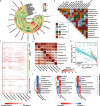Synthetic community derived from grafted watermelon rhizosphere provides protection for ungrafted watermelon against Fusarium oxysporum via microbial synergistic effects
- PMID: 38840214
- PMCID: PMC11151650
- DOI: 10.1186/s40168-024-01814-z
Synthetic community derived from grafted watermelon rhizosphere provides protection for ungrafted watermelon against Fusarium oxysporum via microbial synergistic effects
Abstract
Background: Plant microbiota contributes to plant growth and health, including enhancing plant resistance to various diseases. Despite remarkable progress in understanding diseases resistance in plants, the precise role of rhizosphere microbiota in enhancing watermelon resistance against soil-borne diseases remains unclear. Here, we constructed a synthetic community (SynCom) of 16 core bacterial strains obtained from the rhizosphere of grafted watermelon plants. We further simplified SynCom and investigated the role of bacteria with synergistic interactions in promoting plant growth through a simple synthetic community.
Results: Our results demonstrated that the SynCom significantly enhanced the growth and disease resistance of ungrafted watermelon grown in non-sterile soil. Furthermore, analysis of the amplicon and metagenome data revealed the pivotal role of Pseudomonas in enhancing plant health, as evidenced by a significant increase in the relative abundance and biofilm-forming pathways of Pseudomonas post-SynCom inoculation. Based on in vitro co-culture experiments and bacterial metabolomic analysis, we selected Pseudomonas along with seven other members of the SynCom that exhibited synergistic effects with Pseudomonas. It enabled us to further refine the initially constructed SynCom into a simplified SynCom comprising the eight selected bacterial species. Notably, the plant-promoting effects of simplified SynCom were similar to those of the initial SynCom. Furthermore, the simplified SynCom protected plants through synergistic effects of bacteria.
Conclusions: Our findings suggest that the SynCom proliferate in the rhizosphere and mitigate soil-borne diseases through microbial synergistic interactions, highlighting the potential of synergistic effects between microorganisms in enhancing plant health. This study provides a novel insight into using the functional SynCom as a promising solution for sustainable agriculture. Video Abstract.
Keywords: Community simplification; Disease suppression; Interspecific synergy; Synthetic community.
© 2024. The Author(s).
Conflict of interest statement
The authors declare no competing interests.
Figures




References
MeSH terms
Supplementary concepts
Grants and funding
LinkOut - more resources
Full Text Sources

